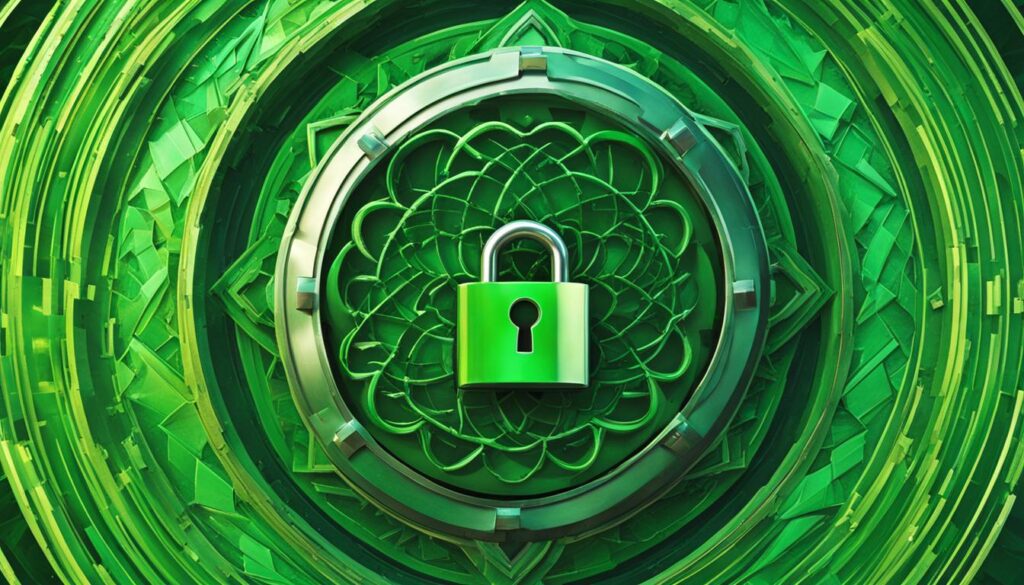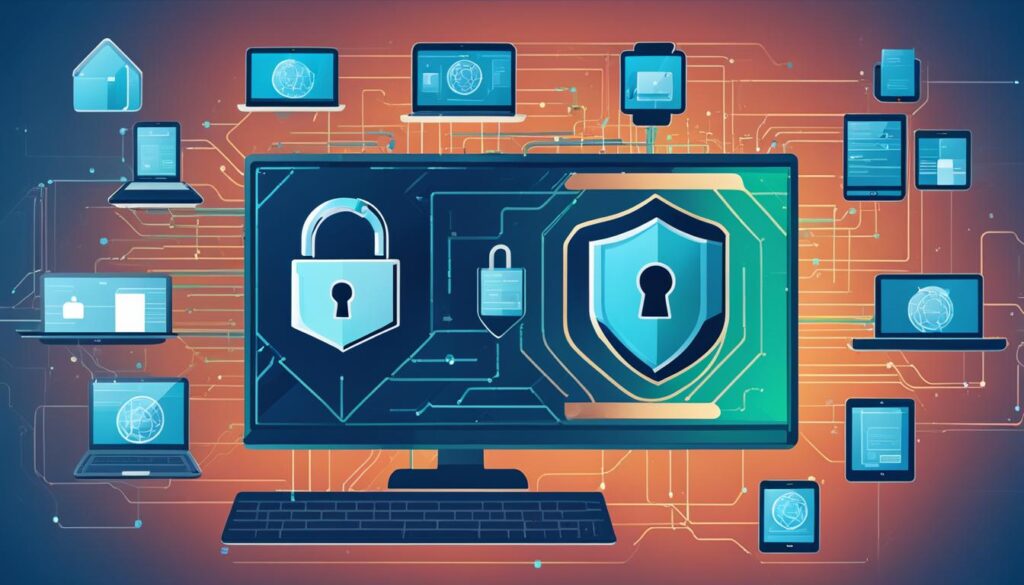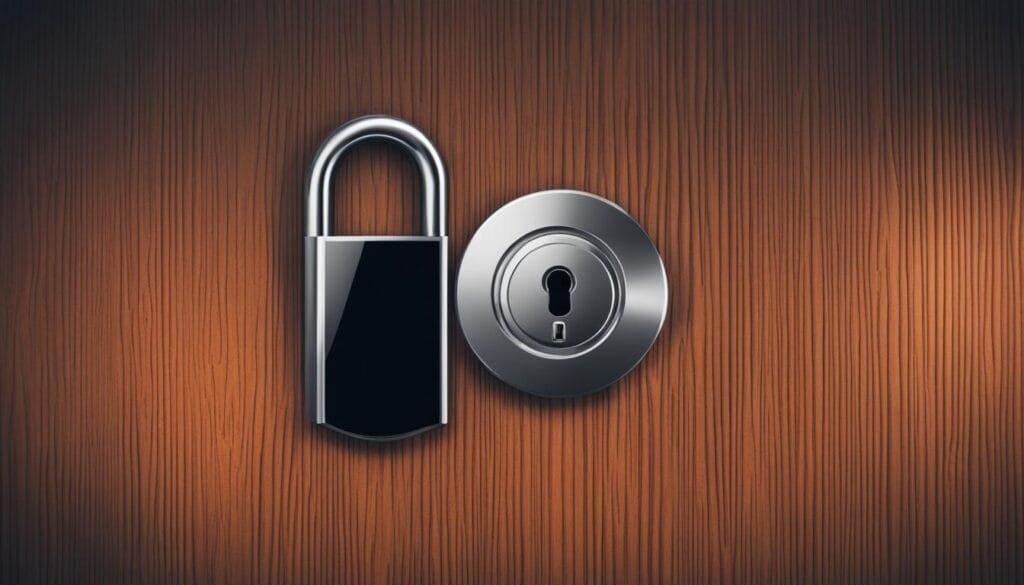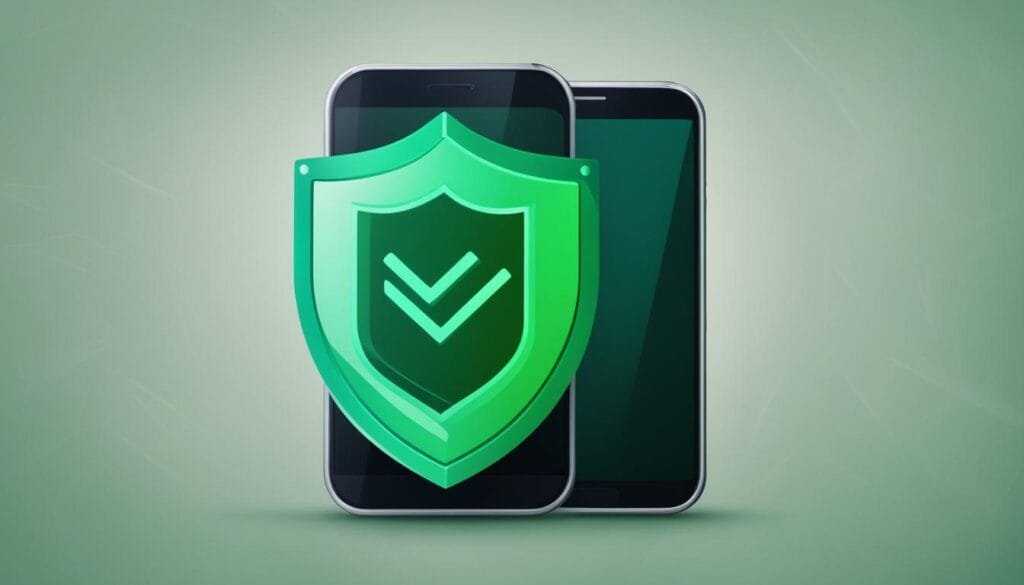Wi-Fi has revolutionized the way we access information and conduct business online. However, when it comes to mobile banking, using Wi-Fi on public networks can pose significant risks to your personal and financial information. While completely avoiding Wi-Fi may not be realistic, it is crucial to be aware of the potential dangers and take precautions to ensure secure Wi-Fi use.
Key Takeaways:
- Secure Wi-Fi use is essential for mobile banking on public networks.
- Using unsecured public Wi-Fi networks puts your personal and financial information at risk.
- Implementing security measures such as using a VPN and keeping your operating system updated can help protect your data.
- Avoid online banking on public Wi-Fi networks and opt for secure private connections whenever possible.
- Regularly monitoring your bank accounts and practicing caution when recognizing and reporting scammers is crucial for secure online banking.
Understanding the Risks of Public Wi-Fi
Public Wi-Fi networks pose significant risks to the security of personal and financial information. When connecting to a public Wi-Fi network, there is a possibility that your data could be intercepted by hackers who are also connected to the same network. These networks are often unencrypted, which means that any information you transmit can be easily accessed by malicious actors.
To fully grasp the potential risks of using Wi-Fi on unsecured networks, it’s important to understand the concept of data encryption. Encryption is a process that converts your data into a code, making it unreadable to anyone who doesn’t have the proper decryption key. Public Wi-Fi networks often lack this crucial layer of protection, leaving your sensitive information vulnerable to interception.
Wi-Fi risks extend beyond just the lack of encryption. Cybercriminals can also set up fake Wi-Fi networks, known as “evil twin” networks, that mimic legitimate networks. When users unknowingly connect to these networks, their data can be easily intercepted and manipulated. This highlights the importance of being cautious when choosing which Wi-Fi network to connect to and verifying its authenticity.
It is clear that public Wi-Fi networks present serious security risks. The next section will provide practical tips for secure Wi-Fi use, which can help mitigate these risks and ensure the safety of your personal and financial data.
Tips for Secure Wi-Fi Use
When it comes to using Wi-Fi, whether on public networks or at home, it is crucial to prioritize network security. Taking the necessary precautions can help safeguard your personal and financial information from potential threats. Here are some valuable tips for secure Wi-Fi use:
1. Keep your operating system updated
Regularly updating your device’s operating system is essential for maintaining the latest security patches and bug fixes. These updates often address vulnerabilities that could be exploited by hackers. Enable automatic updates for a seamless and hassle-free experience.
2. Use a secure connection
When connecting to Wi-Fi, ensure that you are using a secure network. Look for networks that require a password or have network authentication measures in place. Avoid connecting to open, unsecured networks, as they are more susceptible to hacking and data interception.
3. Utilize a VPN
Virtual Private Networks (VPNs) are powerful tools for enhancing network security. By encrypting your internet connection, VPNs provide an additional layer of protection against potential threats. Consider using a reputable VPN service to safeguard your data and maintain privacy while using public Wi-Fi networks.
4. Be cautious with hotspot safety
Public Wi-Fi hotspots are convenient for accessing the internet on the go, but they can also be risky. When using a hotspot, avoid accessing sensitive information or conducting financial transactions if possible. If you must use a hotspot for these purposes, ensure that it is a trusted and secure network. Exercise caution and be mindful of potential risks.
5. Use security software
Investing in reliable security software is crucial for protecting your devices against malware, viruses, and other cyber threats. Keep your security software updated and perform regular scans to detect and remove any potential threats. Additionally, consider using a reputable browser that offers built-in security features to further enhance your online safety.
6. Regularly monitor your bank accounts
Regularly monitoring your bank accounts is an essential practice for detecting any unauthorized activity or suspicious transactions. Set up notifications and alerts to stay informed about any changes or activity related to your accounts. If you notice anything suspicious, contact your bank immediately.
By following these tips for secure Wi-Fi use, you can minimize the risks associated with using public networks and protect your personal and financial information. Remember to prioritize network security and stay vigilant against potential threats in the online realm.
The Risks of Online Banking on Public Wi-Fi
Online banking on public Wi-Fi networks is highly discouraged due to the security risks involved. Public Wi-Fi networks are often unsecured and lack the encryption and authentication necessary to protect sensitive information. When you connect to a public Wi-Fi network, your data could be intercepted by hackers who are connected to the same network.
Without proper encryption, hackers can easily gain access to your usernames, passwords, and other personal information. This puts your bank accounts and financial data at risk of being compromised. It’s important to understand that even if a website has its own security measures in place, connecting to it through an unsecured Wi-Fi network can still leave your information vulnerable.
One way hackers can exploit public Wi-Fi networks is through a technique called “man-in-the-middle” attacks. In these attacks, the hacker intercepts the communication between your device and the intended website, allowing them to capture sensitive data such as login credentials or credit card information. These attacks can be difficult to detect, making it even more important to avoid conducting online banking transactions on public Wi-Fi networks.
The Risks of Online Banking on Public Wi-Fi
“Using public Wi-Fi networks for online banking puts your personal and financial information at significant risk. It’s like broadcasting your banking activity to anyone with the right tools and knowledge.” – Cybersecurity Expert
| Risks | Consequences |
|---|---|
| Data Interception | Hackers can intercept your sensitive information, such as usernames and passwords, leading to unauthorized access to your bank accounts. |
| Man-in-the-Middle Attacks | Hackers can intercept the communication between your device and the website, allowing them to capture sensitive data and compromise your online banking transactions. |
| Unsecured Networks | Public Wi-Fi networks often lack proper encryption and authentication, making it easier for hackers to gain access to your personal and financial information. |
To protect yourself from these risks, it is recommended to avoid online banking on public Wi-Fi networks altogether. Instead, use secure private connections, such as virtual private networks (VPNs), which encrypt your data and provide a secure tunnel for your online activities. Additionally, make sure to keep your devices and security software up to date, use strong and unique passwords, and regularly monitor your bank accounts for any suspicious activity.

Best Practices for Secure Online Banking
When it comes to online banking, implementing security measures is crucial to protect your personal and financial information. By following best practices, you can minimize the risk of unauthorized access and potential fraud. Here are some key steps to ensure secure online banking:
- Use a Trusted Computer: It is important to use a secure and trusted computer when accessing your online banking accounts. Make sure your computer has up-to-date antivirus software, a firewall, and the latest operating system updates. This will help safeguard your information from malware and other security threats.
- Keep Security Software Up to Date: Regularly update your security software, including antivirus and anti-malware programs. These updates often include patches for the latest security vulnerabilities, ensuring that your computer is protected against emerging threats.
- Enable Two-Factor Authentication: Two-factor authentication adds an extra layer of security to your online banking accounts. By requiring a second form of verification, such as a unique code sent to your mobile device, it significantly reduces the risk of unauthorized access even if your login credentials are compromised.
- Practice Caution Recognizing and Reporting Scammers: Be vigilant when it comes to recognizing and reporting phishing scams and other fraudulent activities. Avoid clicking on suspicious links or providing personal information in response to unsolicited requests. If you encounter any suspicious activity, report it to your bank immediately.
Table: Benefits of Best Practices for Secure Online Banking
| Benefits | Description |
|---|---|
| Enhanced Protection | Implementing security measures helps protect personal and financial information from unauthorized access and potential fraud. |
| Reduced Risk | Using trusted computers, keeping security software up to date, and enabling two-factor authentication significantly reduce the risk of online banking-related security breaches. |
| Increased Peace of Mind | Following best practices for secure online banking gives you confidence that your sensitive information is well-protected. |
By following these best practices, you can enjoy the convenience of online banking while minimizing the potential risks. Remember to always stay vigilant and keep yourself informed of the latest security threats and practices to ensure a secure online banking experience.
How to Identify Secure Wi-Fi Networks
When it comes to online banking, ensuring the security of your Wi-Fi network is essential. By following certain guidelines, you can identify secure networks and protect your personal and financial information. Here are some tips to help you identify secure Wi-Fi networks:
Check for a lock symbol or “https://”
One way to identify a secure Wi-Fi network is to check for a lock symbol or “https://” in the address bar of your browser. These indicators signify that the connection is encrypted, ensuring that your data is protected from unauthorized access. Avoid connecting to networks that do not have these security features.
Verify the network name
Another important step is to verify the network name before connecting. Hackers often set up fake networks with names similar to legitimate ones, in an attempt to deceive users. Make sure to double-check the network name with the establishment or venue providing the Wi-Fi before connecting. This simple verification can help ensure the authenticity and security of the network.
Trust reputable networks
When in doubt, it is best to trust reputable networks. Established businesses, hotels, and coffee shops often provide secure Wi-Fi connections for their customers. These networks are usually more reliable and have taken the necessary measures to protect their users’ data. Prioritize connecting to these trusted networks to minimize the risks associated with public Wi-Fi.

Summary
Identifying secure Wi-Fi networks is crucial to safeguarding your personal and financial information while banking online. By checking for encryption indicators, verifying network names, and trusting reputable networks, you can minimize the risks associated with public Wi-Fi. Remember to prioritize security and take proactive measures to protect your data.
Alternatives to Public Wi-Fi for Secure Online Banking
Given the risks associated with public Wi-Fi networks, it is crucial to explore alternative options for secure online banking. By utilizing these alternatives, individuals can significantly enhance the security of their financial transactions and safeguard their personal information.
Virtual Private Networks (VPNs)
A VPN is a powerful tool that can provide a secure and private connection when accessing the internet. It creates an encrypted tunnel between your device and the internet, protecting your data from prying eyes. When using a VPN for online banking, all your information is securely transmitted through the VPN server, making it nearly impossible for hackers to intercept or access your sensitive data.
By connecting to a VPN before accessing your online banking platform, you can ensure that your data remains secure, even if you are using a public Wi-Fi network. VPNs add an extra layer of protection by encrypting your internet traffic and masking your IP address, making it difficult for hackers to track your online activities or compromise your personal information.

| VPN Service Provider | Features | Pricing |
|---|---|---|
| Provider A | High encryption, global server network | $9.99/month |
| Provider B | User-friendly interface, unlimited bandwidth | $6.99/month |
| Provider C | Strict no-logs policy, multi-device support | $12.99/month |
Two-Factor Authentication (2FA)
In addition to utilizing a VPN, implementing two-factor authentication (2FA) can further enhance the security of your online banking experience. 2FA requires you to provide two forms of identification before gaining access to your account, adding an extra layer of security beyond just a password.
Typically, 2FA involves something you know (such as a password) and something you have (such as a unique code sent to your mobile device). This ensures that even if your password is compromised, an attacker would still need physical access to your mobile device in order to gain unauthorized access to your online banking account.
Implementing 2FA for your online banking accounts adds an additional level of protection and helps to prevent unauthorized access to your financial information. Many banks and financial institutions offer 2FA as an option, so be sure to enable this feature for enhanced security.
Conclusion
In conclusion, secure Wi-Fi use is crucial, especially when it comes to mobile banking on public networks. While it may not be possible to eliminate all risks, taking precautions such as using secure networks, implementing security measures, and avoiding public Wi-Fi for online banking can help safeguard personal and financial information.
When using Wi-Fi for online banking, it is important to be aware of the potential dangers posed by public networks. Public Wi-Fi networks are often unsecured, making them prime targets for hackers looking to intercept sensitive information. By understanding the risks and vulnerabilities associated with public Wi-Fi, individuals can make informed decisions and take appropriate measures to protect their data.
Best practices for secure Wi-Fi use include keeping operating systems updated, using cellular networks instead of Wi-Fi for mobile banking, and using credit cards for online shopping. Additionally, it is essential to use security software, trust your browser, and regularly monitor your bank accounts for any suspicious activity. By following these practices, individuals can enjoy the convenience of online banking while minimizing the potential risks.
While Wi-Fi is a convenient way to access information and conduct business online, it is crucial to prioritize security when it comes to online banking. By using secure networks, implementing security measures, and avoiding public Wi-Fi for online banking, individuals can take proactive steps to protect their personal and financial information. Remember, securing your Wi-Fi connection is an ongoing process, and staying vigilant is key to ensuring a safe online banking experience.
FAQ
Is it safe to use Wi-Fi for mobile banking on public networks?
Using Wi-Fi on public networks for mobile banking can pose risks to your personal and financial information. It’s recommended to avoid it if possible.
What are the risks of using Wi-Fi on public networks?
Public Wi-Fi networks are often unsecured, making them prime targets for hackers who can intercept your data and gain access to sensitive information.
How can I safely use Wi-Fi, whether it’s on public networks or at home?
It’s important to keep your operating system updated, use cellular networks instead of Wi-Fi for mobile banking, and use credit cards for shopping. Additionally, ensure your devices’ automatic connection settings are controlled, use security software, trust your browser, and regularly monitor your bank accounts.
Why is online banking on public Wi-Fi networks discouraged?
Public Wi-Fi networks lack encryption and authentication, making them highly vulnerable to hackers. It’s best to avoid using them for online banking altogether.
What are the best practices for ensuring secure online banking?
It’s important to use a trusted computer, keep security software up to date, install a firewall, and regularly back up important files. Utilizing two-factor authentication and being cautious when recognizing and reporting scammers are also recommended.
How can I confirm the security of a Wi-Fi network?
Look for a lock symbol or “https://” in the address bar and verify the network name. Trust reputable networks and avoid connecting to suspicious or unauthenticated networks.
Are there alternative options for online banking other than public Wi-Fi?
Yes, you can explore secure private connections such as VPNs and prioritize utilizing two-factor authentication for added security when conducting financial transactions online.
Are There Any Special Security Measures I Should Take When Using Mobile Banking on Public Wi-Fi?
When using mobile banking on public Wi-Fi, it’s crucial to follow best practices for secure mobile banking. Protect your personal information by connecting to a trusted network, using a Virtual Private Network (VPN), and ensuring your banking app is up to date. Avoid accessing sensitive data in public and be cautious of suspicious links or emails. Stay vigilant to keep your mobile banking experience safe.

